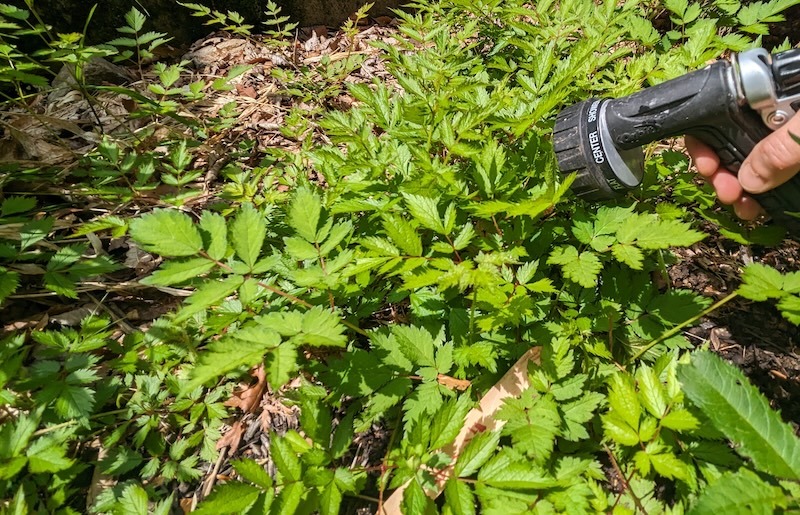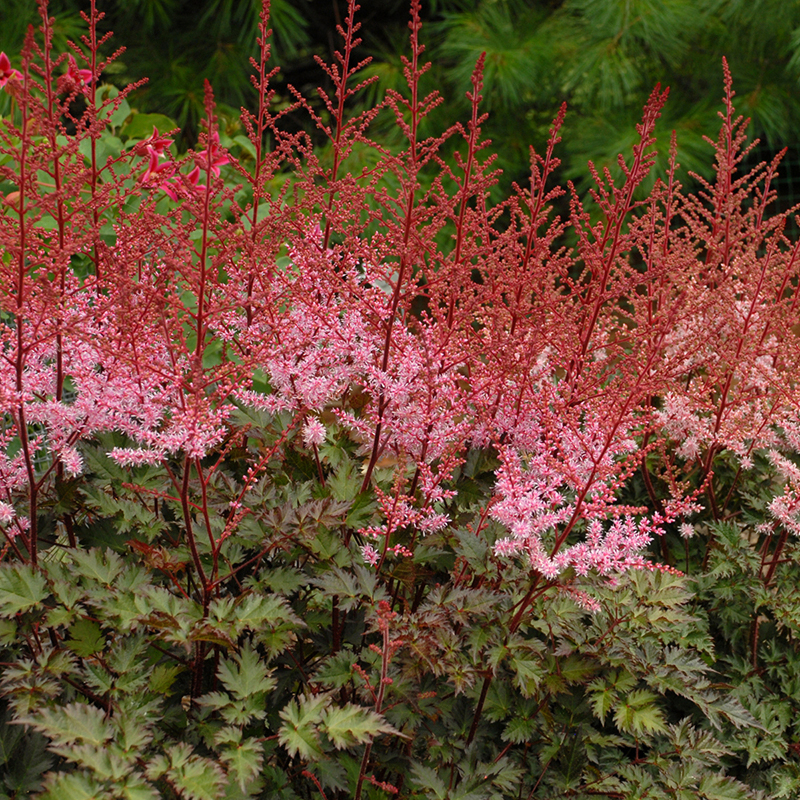Astilbe are indispensable year-round assets to the shade garden, offering ferny foliage, long-blooming striking flowers, vertical presence, and persistent seed heads in winter. They are hardy from zones 3-9.
The flowers vary from upright fans to graceful plumes, and the pink, red, or white flowers attract butterflies. Plants range from six inches high to five feet tall, and many offer striking foliage with bronze or purple tints. Some of the popular species are Astilbe chinensis, A. japonica, and A. simplicifolia.

Planting Astilbe
Choose a partially shaded site protected from the hottest sun. They prefer a loamy soil that is acidic or slightly neutral with good drainage. Plant bare-root plants 4-6 inches deep, with the crown 1-2 inches from the surface, and make the hole twice as wide as the root ball. The soil should be consistently moist but not soggy. If the clumps begin to push out of the soil as they expand, cover with soil. Divide every three or four years.
Watering Astilbe
The soil should be consistently moist but not soggy. Deep watering is better than frequent sprinkling to promote root development. A year-round mulch will help retain moisture.

Fertilizing Astilbe
At planting time, and in subsequent springs, apply a balanced slow-release fertilizer to your astilbes. In a container, consider monthly applications of liquid fertilizer. In fall, amend the soil with compost or soil conditioner to encourage the moist, humus-rich conditions they love.
Deadheading Astilbe
Pruning is not needed for astilbe. Astilbe makes a nice cut flower for arrangements. Deadheading will not promote extra flowering. However, when leaves turn yellow in fall you can trim them off to clean it as desired, but it’s not strictly necessary. The seedheads can provide attractive winter interest. Divide every three to four years.

Caring For Astilbe in Pots
Choose a site in partial shade with morning sun rather than afternoon sun, which can scorch astilbe. The pot should have good drainage. Take care to keep the pot well-watered, but not soggy. A slow-release fertilizer at planting is helpful, and monthly liquid fertilizer after that is optional. Leave up seedheads to provide winter interest. Divide every three to four years.
Winter Care for Astilbe
Astilbe doesn't need much winter care. Mulch the plants in the colder regions of its hardiness range. Leave up seedheads to feed the birds and provide winter interest.
Common Astilbe Care Questions
What Is The Growth Rate Of Astilbe?
Astilbe is relatively slow-growing, will sometimes flower the first year, and will continue to bloom for years!
Where Does Astilbe Grow Best?
While many Astilbes will grow in almost any light condition, they will do their best and grow to their full potential when they get at least some sunlight, in moist, slightly acidic, rich soils. Flowering will most certainly be less profuse, in full shade.
What Is The Height Of Astilbe?
There are many varieties of Astilbe, with some only reaching around a foot tall and some can reach up to 4 feet tall.
How To Grow Astilbe From Bulbs And Seeds?
It can be difficult to achieve germination, a quite a long time to grow a plant of substantial size when sowing Astilbe from seed. A better option is dividing a mature plant, as the bulbs easily spread over time.
What Are The Astilbe Colors?
These brightly colored butterfly attractors come in a full range of colors, white to pinks to deep reds, and light lavenders to deep violets.
Does Astilbe Come Back Every Year?
Astilbe are perennial, so they do come back every year!
Why Does Astilbe Leaves Turn Yellow And Brown?
Yellowing leaves on Astilbe is often caused by powdery mildew and can be helped (or avoided) by trimming back the center of the plant to increase air circulation and by watering at the base, careful not to let water get on the foliage. The most common cause of browning astilbe leaves is too much sunlight and not enough water. Astilbe prefers moist soil (apply mulch to help contain moisture) and avoids too much direct sunlight, particularly during the hottest part of the day.
Have a question about Astilbe? Fill out the form below and we will try and get back to your question as soon as possible. We may even feature your question in this article to help other gardeners!
 |
Author Erica Browne Grivas - Published 06-16-2021 |
